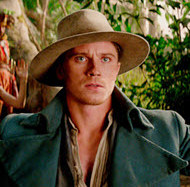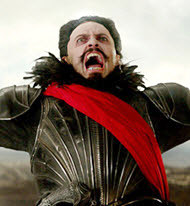Pan
 for fantasy action violence, language and some thematic material.
for fantasy action violence, language and some thematic material.
Reviewed by: Jessica D. Lovett
CONTRIBUTOR
| Moral Rating: | Average |
| Moviemaking Quality: |
|
| Primary Audience: | Adults Teens Kids Family |
| Genre: | Family Fantasy Adventure Comedy Adaptation 3D IMAX |
| Length: | 1 hr. 51 min. |
| Year of Release: | 2015 |
| USA Release: |
October 9, 2015 (wide) DVD: December 22, 2015 |





a band of boys who were lost by their parents
selfishness of childhood / self-centred behaviour
boastful and careless boy
never-ending childhood
forgetfulness
fantasy adventures






| Featuring |
|---|
|
Hugh Jackman … Blackbeard Levi Miller … Peter Pan Rooney Mara … Tiger Lily Cara Delevingne … Mermaid Amanda Seyfried … Mary Garrett Hedlund … Hook See all » |
| Director |
| Joe Wright — “Hanna” (2011), “Atonement” (2007), “Pride & Prejudice” (2005) |
| Producer |
|
Berlanti Productions Dune Entertainment |
| Distributor |
“To truly understand how things end, we must know how they begin.”
Like a wild shopping spree in a candy store, “Pan” exuberantly overwhelms the senses with explosions of vivid color and sugar-rush sweetness. Those expecting a regurgitation of the classic Disney cartoon will be disappointed, as “Pan” is a prequel in the truest sense. Some of the warmly familiar imagery strike a chord—crocodiles, clocks, pirates, Indians—but with a renewed sense of how those elements fit into the new backstory. There are also plenty of literary nods to those who know Barrie’s original Peter Pan stories, like having a character run through Kensington Gardens in London.
Honestly, I was expecting an entertaining, yet slightly stale, retelling of the same ol’ tale, but I was stunned at the creativity and brilliance that this new twist brings to familiar characters, explaining how the original story came into being. “Pan” felt like an independent art film that was suddenly gifted a decent budget, causing it to blossom outward, accordingly. It skillfully mixes the fairy-flying whimsy and swashbuckling heroics of the book with a darkly modernized villain who is sharpened into a three-dimensional character, largely due to Hugh Jackman’s deep portrayal of the pirate’s twisted sense of justice.
Without adding too many spoilers, “Pan” is the story of a 12-year-old orphan named Peter who, as an infant, was left on the doorstep of an orphanage by his mysterious mother. It turns out that Mother Barnabas, the abusive, cruel head nun running the orphanage is in league with pirates, selling orphans to them in exchange for gold. In their rummaging for the truth, Peter and Nibs find a letter from Peter’s mother in his personal file. Peter’s mother had written that she will always love him and promises to be reunited with him someday, giving Peter renewed hope of escaping the harsh orphanage life. Peter and his friend Nibs try to expose Mother Barnabas’s plot, but Peter ends up being taken by the pirates and taken to Neverland where he learns his true destiny!
One amazing thing about this film is that it mixes several seemingly unrelated cultures and styles together (Steampunk, Native American, Indian, cowboy/western, Gothic, WWII era Britain, and modern rock) in an intriguing narrative collage that somehow meshes together seamlessly. There are heroic characters that are self-sacrificing, brave, kind, and loyal—including two strong female warrior characters who show their strength respectfully and with humility toward male characters. Beside the good examples of character present in the film, there are several cautions.
The pirates are painted in such a way that they could be too scary for younger viewers, so use caution before bringing young children. They are definitely nightmare fodder, but do not cross the horror film line, feeling like a sort of cross between circus freak show acts and ragged, ruffled Victorian era pirates. One pirate has three dried human hearts pinned to his vest, but this is only flashed by briefly. The pirates are sadistic and grin menacingly as they kill, but their gunshots are muted in their scariness by the fact that multicolored paint powder bursts forth when people are shot, splattering rainbows, rather than bloody gore.
Certain nuns at the orphanage are seen in a merciless light, but, in my opinion, neither Catholicism nor religion itself are demonized. Peter is seemingly abandoned by his mother, boys are physically and verbally abused by the orphanage workers, kids are abducted by pirates and enslaved in mines. There are also brief scenes with WWII bombers flying over and bombs exploding.
There is no language besides one “heck,” one “darn,” “damnation,” and a “bloody hell.” There are the obvious supernatural elements of the Peter Pan mythology and plenty of action sequences including giant crocodiles, angry natives, and such. There are also completely censored, yet still topless, mermaids and brief drug use by the pirate captain. Tiger Lily’s outfit bares her tummy and little cleavage.
The darker fairytale elements are tempered by pirate ships soaring through space, fairies fighting pirates in crystal caves, and other visual feasts of fantasy. This film is certainly no darker than the book itself or than classic Grimm fairy tales—though given the modern wings of expert CGI, please exercise caution with younger, more sensitive viewers. In short, if you are are a fantasy or classic literature enthusiast and aren’t scared by Hugh Jackman with false teeth and pale, scarred makeup or by huge toothy crocodiles leaping over and attacking ships, you may enjoy this “PG” film.
Violence: Moderate to heavy / Profanity: Minor / Sex/Nudity: Mild
See list of Relevant Issues—questions-and-answers.


Moral rating: Good / Moviemaking quality: 5
If you are an adult looking for clean entertainment, but don’t have children, I would take a pass on this. It’s clean enough, but lacking professionalism.
Moral rating: Average / Moviemaking quality: 3½
So, mother Mary… awaited messiah… son of a king… obviously there’s biblical inspiration. However, some of the cinematography was nice and there were some funny moments.
Moral rating: Average / Moviemaking quality: 3
Moral rating: Offensive / Moviemaking quality: 2
The Feminist would love this movie. It’s not about the Pan (Peter Pan), it’s really about the swash buckling woman Princess warrior who fights and beats most all the pirate men. Long footage of film was wasted on the fight between her and the Captain Hook imposter. That scene should have been for the Pan to fight the captain, not the girly (all man) woman showing off a million fighting skills. I’m getting tired, yes so tired, of seeing these Hollywood movies showing our sons of America that women, after all, can do all the best fighting, and they will be good in military combat instead of them. See all »
Moral rating: Offensive / Moviemaking quality: 4
PLEASE share your observations and insights to be posted here.


I realize that others might be put off by his lack of fighting, but I think it works. He’s an inexperienced little boy who knows nothing about fighting with a knife, or even his fists, so it should be expected that he would leave that type of fighting to those more experienced while he struggles to learn how to fly.
While the head nun was depicted in a bad light, I didn’t think it was too offensive or meant to reflect on the Catholic church as a whole. She was simply an end to a means, to show that the boys were living in a horrible situation, and I’m sure in those days the majority of orphanages were run by the church. Of course, as usual, there will be people who read way too much into her depiction, but it fit into the storyline and nicely set up the reason for the ending. See all »
My Ratings: Moral rating: Better than Average / Moviemaking quality: 5